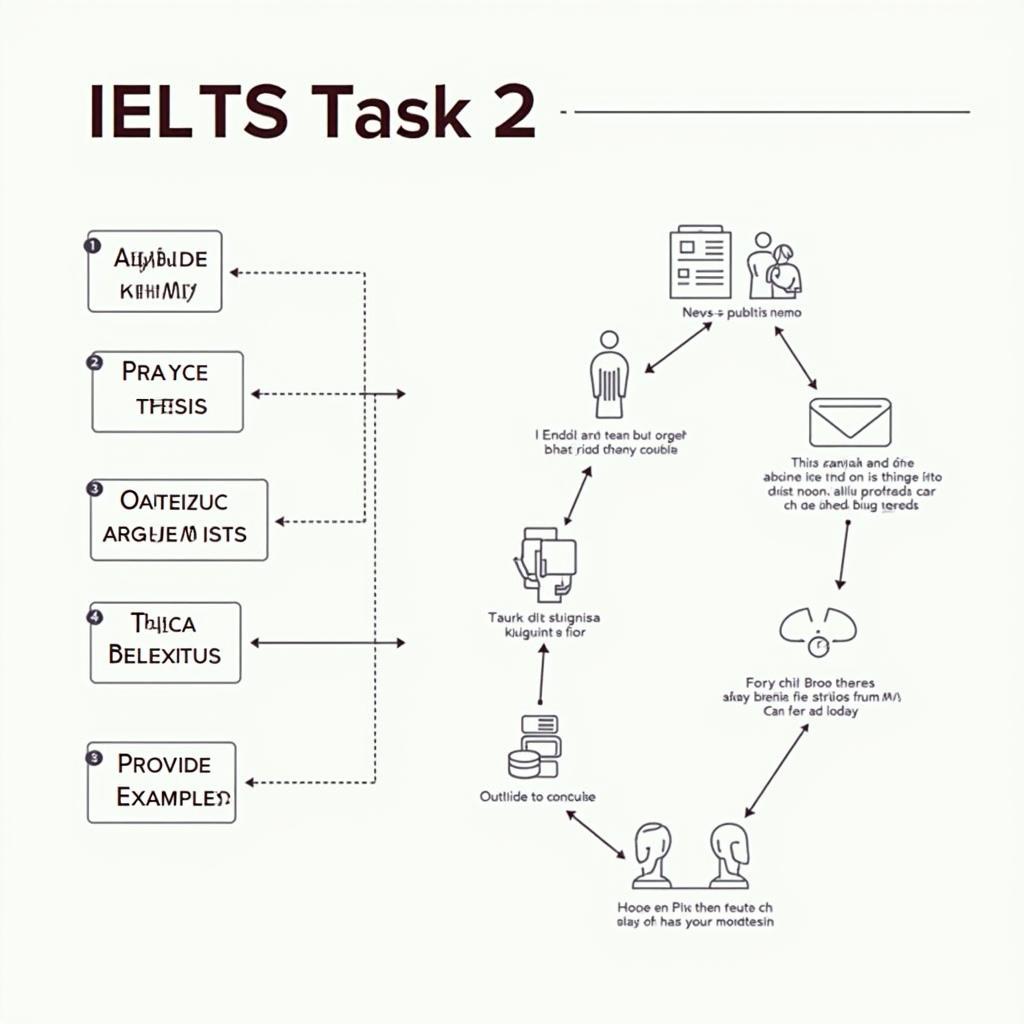Trong hơn 20 năm dạy IELTS Writing, tôi thường xuyên thấy chủ đề The Influence Of Global Media On Public Opinion xuất hiện dưới nhiều biến thể: từ “news media” đến “social media”, từ “ảnh hưởng tích cực/tiêu cực” đến “độ tin cậy và kiểm chứng thông tin”. Đây là “mỏ điểm” nếu bạn nắm chắc tư duy lập luận, từ vựng học thuật và cách trình bày cân bằng. Bài viết này giúp bạn: 1) luyện 3 bài mẫu Band 5-6, 6.5-7 và 8-9; 2) hiểu cách chấm điểm chi tiết theo 4 tiêu chí; 3) học từ vựng-chủ điểm, cấu trúc câu “ăn điểm”; 4) có checklist thực hành trong phòng thi.
Một số đề thi/đề tham khảo đã được cộng đồng xác tín và lưu trữ trên các nguồn uy tín như IELTS Liz, IELTS-Blog, British Council:
- “News media has an increasing influence on people’s lives. Some people believe this is a negative development. To what extent do you agree or disagree?” (đề phổ biến về ảnh hưởng của truyền thông tin tức)
- “The mass media has great influence in shaping people’s ideas. Discuss the advantages and disadvantages and give your own opinion.” (đề bàn lợi-hại của truyền thông đại chúng)
- “More and more people get news from social media rather than newspapers. Do the advantages of this trend outweigh the disadvantages?” (đề về dịch chuyển sang mạng xã hội)
Đối với những ai quan tâm đến bức tranh rộng hơn về toàn cầu hóa và tác động xã hội, nội dung này có điểm tương đồng với the influence of global fashion trends on local cultures khi đều bàn về dòng chảy xuyên biên giới ảnh hưởng đến nhận thức và hành vi. Bạn có thể xem thêm tại: https://vn.ielts.net/the-influence-of-global-fashion-trends-on-local-cultures/
 Ảnh minh họa về the influence of global media on public opinion và IELTS Writing Task 2
Ảnh minh họa về the influence of global media on public opinion và IELTS Writing Task 2
1. Đề Writing Part 2
News media has an increasing influence on people’s lives. Some people believe this is a negative development. To what extent do you agree or disagree?
Dịch đề: Một số người cho rằng truyền thông tin tức ngày càng có ảnh hưởng lớn đến cuộc sống con người và đây là một xu hướng tiêu cực. Bạn đồng ý hay không, và ở mức độ nào?
Phân tích đề bài:
- Dạng câu hỏi: Opinion (To what extent do you agree or disagree?). Bạn phải đưa ra lập trường rõ ràng (đồng ý/không đồng ý/một phần) và bảo vệ quan điểm xuyên suốt.
- Thuật ngữ quan trọng:
- “News media”: báo in, truyền hình, radio, nền tảng số, mạng xã hội cung cấp tin tức.
- “Negative development”: hệ quả bất lợi như thông tin sai lệch, giật gân, thiên kiến thuật toán, buồng vang (echo chambers).
- Lỗi thường gặp:
- Lạc đề sang “giải trí” hoặc “quảng cáo” mà không gắn với tin tức/dư luận.
- Nêu ví dụ chung chung, không giải thích cơ chế ảnh hưởng đến public opinion (dư luận).
- Quan điểm mơ hồ (mở nói A, thân bài nói B).
- Cách tiếp cận chiến lược:
- Chọn lập trường cân bằng: thừa nhận lợi ích (nâng cao nhận thức, trách nhiệm giải trình), đồng thời chỉ rõ rủi ro (misinformation, polarization).
- Triển khai theo logic: Cơ chế tác động → Ví dụ minh họa → Giải pháp/điều kiện để tối ưu lợi ích, giảm hại.
- Luôn liên kết tới “public opinion” (dư luận): giải thích cách truyền thông định khung (framing), thiết lập nghị trình (agenda-setting), và khuếch đại.
Tương tự như cách các quyết định tiền tệ tác động dây chuyền lên thị trường, hiện tượng định hướng dư luận cũng có cơ chế truyền dẫn. Để hiểu cách thông tin ảnh hưởng hành vi đám đông một cách hệ thống, bạn có thể xem thêm: https://vn.ielts.net/how-central-bank-decisions-influence-stock-markets/
 Sơ đồ chiến lược viết IELTS Task 2 về the influence of global media on public opinion
Sơ đồ chiến lược viết IELTS Task 2 về the influence of global media on public opinion
2. Bài mẫu Band 8-9 về the influence of global media on public opinion
Bài Band 8-9 cần: lập trường nhất quán, phát triển ý sâu, ví dụ có tính khái quát, từ vựng học thuật chính xác, liên kết mượt.
Essay (≈300 words):
In an era of ubiquitous connectivity, news media undoubtedly shapes how citizens interpret events. While critics claim this expanding reach is inherently harmful, I contend that its influence is conditionally beneficial: it can strengthen informed citizenship when governed by robust standards, but it becomes corrosive where algorithms and sensationalism go unchecked.
To begin with, global news flows can elevate public literacy on complex issues. Through agenda-setting and explanatory journalism, reputable outlets distill scientific findings and policy trade-offs into accessible narratives. When audiences are exposed to comparative data and diverse voices, they are more likely to scrutinize claims, demand accountability, and calibrate opinions rather than react impulsively. The rise of cross-border investigations has, for instance, pressured institutions to address corruption and environmental abuses, demonstrating media’s capacity to align public opinion with the public interest.
Nevertheless, the same infrastructure can distort consensus. Recommendation engines often optimize for engagement, not enlightenment, thus amplifying outrage, echo chambers, and misinformation. Sensational headlines compress nuance; conflict is framed as a binary; and corrections rarely travel as far as the original falsehood. In such ecosystems, opinion formation becomes a product of virality, with cognitive biases skillfully “micro-targeted.”
The remedy is not to decry the medium but to reform its incentives. Platform transparency, third-party fact-checking, media literacy in school curricula, and clearer labeling of opinion versus reporting can reorient attention toward verifiable claims. When quality is discoverable and rewarded, the media’s influence tends to be constructive: citizens converge on shared facts while still debating values.
In short, the expanding footprint of news media is neither a panacea nor a pathology. Its impact on public opinion depends on editorial integrity and algorithmic design. With the right guardrails, broader reach can mean better judgment.
Phân tích Band điểm
| Tiêu chí | Band | Nhận xét |
|---|---|---|
| Task Response (Hoàn thành yêu cầu) | 8.5 | Lập trường rõ ràng “conditionally beneficial”, trả lời đúng “to what extent”, phát triển hai mặt và đề xuất giải pháp. Ví dụ mang tính hệ thống (agenda-setting, algorithms) chứ không liệt kê rời rạc. |
| Coherence & Cohesion (Mạch lạc & Liên kết) | 8.0 | Mở–Thân 1–Thân 2–Giải pháp–Kết luận mạch lạc, dùng chủ đề câu rõ. Dụng ý liên kết logic (Nevertheless, The remedy…) nhịp nhàng; không lạm dụng từ nối. |
| Lexical Resource (Từ vựng) | 8.5 | Từ vựng học thuật chuẩn xác: agenda-setting, explanatory journalism, micro-targeted, incentives, guardrails. Collocations tự nhiên và đa dạng. Không có lỗi lựa chọn từ. |
| Grammatical Range & Accuracy (Ngữ pháp) | 8.0 | Câu phức, mệnh đề quan hệ, phân từ, song song cấu trúc. Độ chính xác cao, dấu câu chuẩn; nếu có lỗi thì rất hiếm và không ảnh hưởng hiểu. |
Các yếu tố giúp bài này được chấm điểm cao
- Luận điểm “conditionally beneficial” trả lời trực tiếp mức độ đồng ý, tránh nước đôi mơ hồ.
- Triển khai theo cơ chế tác động: agenda-setting → nhận thức → hành vi công dân.
- Đối sánh hệ thống: lợi ích thông tin hóa vs. rủi ro thuật toán và giật gân.
- Từ vựng chuyên sâu vừa đủ, đi kèm giải thích ngắn, tránh “khoe từ”.
- Đưa giải pháp khả thi: transparency, fact-checking, media literacy, labeling.
- Câu chủ đề mở đoạn mạnh, kết đoạn neo ý (“constructive”, “guardrails”).
- Ví dụ khái quát (cross-border investigations) thay vì ví dụ chính trị nhạy cảm.
3. Bài mẫu Band 6.5-7 về the influence of global media on public opinion
Band 6.5-7 cần trả lời đúng trọng tâm, có ví dụ cụ thể, mạch lạc ổn; từ vựng và ngữ pháp đa dạng vừa phải, đôi chỗ còn lặp hoặc khái quát quá.
Essay (≈265 words):
It is true that news media affects how people think about daily events and big global issues. I partly disagree with the view that this growing influence is negative. When reliable sources explain complex topics in simple language, the public can make better choices and hold leaders accountable. For example, international coverage of climate reports has helped many citizens understand why policies take time and money to implement.
However, problems arise when speed and clicks become more important than accuracy. On social platforms, algorithms tend to push content that triggers strong emotions. As a result, people may only see one side of a story and form opinions too quickly. Headlines are sometimes exaggerated, and corrections arrive late. This clearly harms discussions in families, schools, and workplaces.
Even so, I believe the situation can improve. If platforms show clearer labels for opinion pieces and news reports, readers will know what they are consuming. Schools can add media literacy so students learn to check sources and compare arguments. In addition, independent fact-checkers and public editors can reduce the spread of false information. With such steps, the influence of media can become more balanced and useful for society.
In conclusion, the impact of news media on public opinion depends on quality and design. While there are real risks, we should not ignore the clear benefits of fast information and global perspectives. The best way forward is to raise standards and teach people how to read the news critically.
Phân tích Band điểm
| Tiêu chí | Band | Nhận xét |
|---|---|---|
| Task Response (Hoàn thành yêu cầu) | 7.0 | Lập trường “partly disagree” rõ ràng, có cả lợi–hại–giải pháp. Ví dụ cụ thể (climate reports) nhưng còn hơi chung chung ở vài đoạn. |
| Coherence & Cohesion (Mạch lạc & Liên kết) | 7.0 | Bố cục rõ, dùng nối hợp lý (However, Even so, In conclusion). Liên kết ý ổn nhưng còn lặp cấu trúc câu chủ đề. |
| Lexical Resource (Từ vựng) | 6.5 | Vốn từ phù hợp chủ đề (algorithms, accuracy, media literacy), một số collocation đơn giản. Thiếu vài cụm học thuật sâu như agenda-setting. |
| Grammatical Range & Accuracy (Ngữ pháp) | 6.5 | Câu phức có, ít lỗi. Tuy nhiên cấu trúc chưa thật đa dạng, một số câu đơn lặp. |
So sánh với bài Band 8-9
- Độ sâu lý thuyết: Band 8-9 dùng khung “agenda-setting, incentives, guardrails”; Band 7 thiên về mô tả hiện tượng.
- Collocations: Bài 8-9 giàu collocation học thuật chuẩn xác; bài 7 dùng từ phổ thông, ít biến hoá.
- Cấu trúc câu: Bài 8-9 đa dạng (mệnh đề quan hệ, phân từ, đảo ngữ nhẹ), bài 7 lặp cấu trúc S-V.
- Ví dụ: Bài 8-9 trừu tượng hóa thành cơ chế; bài 7 thiên về ví dụ một chiều, ít phân tích nguyên nhân–hệ quả sâu.
4. Bài mẫu Band 5-6
Band 5-6 thường: ý chưa phát triển đủ, ví dụ mơ hồ, lỗi mạo từ/giới từ/thì, liên kết rời. Dưới đây là bài minh họa có lỗi thực tế được làm nổi bật.
Essay (≈255 words):
People today are surrounded by media and news, so it clearly change how they think. Some people say this is totally bad, but I do not agree. Media can help people know about world events quickly and teach them many knowledge. For instance, when there is health crisis, people can follow advice online and protect themselves.
However, there are also many problems. Some news are fake informations and some headlines are too much exaggerate. Social media sometimes make people only see same opinions and they become more extreme. People also spend too much times on reading and they feel stress. In my opinion, this kind of influence is not good for public opinion because it is not objective enough and bias.
To solve this, the government and schools should teach students how to check source and what is reliable. Platforms should shows warning if a post is suspicious and remove it very quick. Also, journalists must be more responsible and not write clickbait just for views. If these actions are done, media can become more positive and help society.
In conclusion, I think the influence of media is both good and bads. We should not say it is all negative, but we must control it better. Then people can have right information and make good decisions.
Phân tích Band điểm
| Tiêu chí | Band | Nhận xét |
|---|---|---|
| Task Response (Hoàn thành yêu cầu) | 6.0 | Có quan điểm, nêu lợi-hại-giải pháp, nhưng phát triển ý nông, thiếu cơ chế cụ thể tác động đến dư luận. |
| Coherence & Cohesion (Mạch lạc & Liên kết) | 5.5 | Bố cục cơ bản, từ nối đơn giản. Một số câu rời, lặp từ “media/news”. |
| Lexical Resource (Từ vựng) | 5.5 | Lỗi từ vựng/collocation (“fake informations”, “too much exaggerate”). Từ nghèo, lặp, ít học thuật. |
| Grammatical Range & Accuracy (Ngữ pháp) | 5.5 | Lỗi số ít/số nhiều, thì, mạo từ; chia động từ sai; cụm tính từ. Cấu trúc câu đơn giản, ít đa dạng. |
Những lỗi sai của bài – phân tích & giải thích
| Lỗi sai | Loại lỗi | Sửa lại | Giải thích |
|---|---|---|---|
| fake informations | Danh từ không đếm được | fake information | “Information” là không đếm được, không thêm “s”. |
| too much exaggerate | Collocation/Ngữ pháp | overly exaggerated / too much exaggeration | “Exaggerate” là động từ; cần tính từ “exaggerated” hoặc danh từ “exaggeration”. |
| make people only see | Động từ chia số | makes people only see | Chủ ngữ “social media” ở ngôi số ít → “makes”. |
| spend too much times | Số ít/số nhiều | spend too much time | “Time” không đếm được trong nghĩa này. |
| not objective enough and bias | Tính từ–danh từ | not objective enough and is biased | “Biased” là tính từ; cần động từ be phù hợp. |
| shows warning | Chia động từ | show warnings | “Platforms” số nhiều → “show”; thêm “warnings” số nhiều tự nhiên hơn. |
| both good and bads | Danh từ/Adj | both good and bad | “Bad” là tính từ, không thêm “s” |
Cách Cải Thiện Từ Band 6 Lên Band 7
- Mở rộng ý theo cơ chế: “algorithm → echo chamber → polarisation → opinion quality declines”.
- Dùng collocation học thuật: agenda-setting, fact-checking, editorial standards, media literacy.
- Đa dạng cấu trúc: mệnh đề quan hệ, phân từ, câu điều kiện loại 1/2/3 tùy ngữ cảnh.
- Kiểm “ngữ pháp cơ bản”: mạo từ (a/an/the), danh từ đếm được/không đếm được, chủ–vị.
- Ví dụ có số liệu nguồn uy tín hoặc ví dụ khái quát có cơ chế; tránh chung chung.
- Kết luận tóm ý và nhắc lại lập trường bằng từ vựng đồng nghĩa để tránh lặp.
5. Từ vựng quan trọng cần nhớ
| Từ/Cụm từ | Loại từ | Phiên âm | Nghĩa tiếng Việt | Ví dụ | Collocations |
|---|---|---|---|---|---|
| agenda-setting | n. | /əˈdʒendə ˌsetɪŋ/ | thiết lập nghị trình (định hướng chủ đề) | Agenda-setting shapes which issues the public considers urgent. | media agenda-setting; agenda-setting power |
| echo chamber | n. | /ˈekəʊ ˌtʃeɪmbə/ | buồng vang ý kiến | Social feeds can become echo chambers. | algorithmic echo chamber |
| misinformation | n. | /ˌmɪsɪnfəˈmeɪʃn/ | thông tin sai lệch | Misinformation spreads faster than corrections. | spread/counter misinformation |
| sensationalism | n. | /senˈseɪʃənəlɪzəm/ | giật gân | Sensationalism distorts complex debates. | media sensationalism |
| media literacy | n. | /ˈmiːdiə ˈlɪtərəsi/ | hiểu biết truyền thông | Schools should teach media literacy. | digital/media literacy programs |
| fact-checking | n. | /ˈfækt ˌtʃekɪŋ/ | kiểm chứng thông tin | Fact-checking improves trust. | independent fact-checking |
| editorial standards | n. | /ˌedɪˈtɔːriəl ˈstændədz/ | chuẩn mực biên tập | Strong editorial standards reduce bias. | uphold editorial standards |
| algorithmic | adj. | /ˌælɡəˈrɪðmɪk/ | thuộc thuật toán | Algorithmic curation boosts engagement. | algorithmic curation/feeds |
| polarisation (US: polarization) | n. | /ˌpəʊləraɪˈzeɪʃn/ | phân cực | Media polarisation harms deliberation. | political/social polarisation |
| public scrutiny | n. | /ˈpʌblɪk ˈskruːtɪni/ | giám sát của công chúng | Investigations invite public scrutiny. | under public scrutiny |
| guardrails | n. | /ˈɡɑːdreɪlz/ | rào chắn (ẩn dụ: chuẩn bảo vệ) | We need guardrails for platforms. | regulatory/ethical guardrails |
| balanced coverage | n. | /ˈbælənst ˈkʌvərɪdʒ/ | đưa tin cân bằng | Balanced coverage builds trust. | provide balanced coverage |
| to amplify | v. | /ˈæmplɪfaɪ/ | khuếch đại | Algorithms can amplify outrage. | amplify voices/misinformation |
| to calibrate opinions | v. | /ˈkælɪbreɪt/ | hiệu chỉnh quan điểm | Data helps citizens calibrate opinions. | carefully calibrate opinions |
| critical reading | n. | /ˈkrɪtɪkl ˈriːdɪŋ/ | đọc phản biện | Critical reading reduces gullibility. | encourage critical reading |
6. Cấu trúc câu dễ ăn điểm cao
- Câu phức với mệnh đề phụ thuộc
- Công thức: [Mệnh đề phụ thuộc] +, + [Mệnh đề chính] hoặc ngược lại.
- Ví dụ (trích Band 8-9): When quality is discoverable and rewarded, the media’s influence tends to be constructive.
- Vì sao ghi điểm: Thể hiện quan hệ điều kiện–kết quả rõ ràng, tăng mạch lạc.
- Ví dụ bổ sung: If platforms prioritise accuracy, public debate improves. Although speed matters, verification must come first.
- Lỗi thường gặp: Thiếu dấu phẩy khi mệnh đề phụ thuộc đứng trước; thì động từ sai sau “if”.
- Mệnh đề quan hệ không xác định (non-defining relative clause)
- Công thức: Danh từ, which/who + V, … (cách ly bằng dấu phẩy).
- Ví dụ: This infrastructure, which optimises for engagement, can distort consensus.
- Vì sao ghi điểm: Bổ sung thông tin nền mượt mà, tăng độ học thuật.
- Ví dụ bổ sung: Editorial integrity, which underpins trust, is non-negotiable. Algorithms, which are opaque, require scrutiny.
- Lỗi: Nhầm which/that; quên dấu phẩy.
- Cụm phân từ (participle phrase)
- Công thức: V-ing/V-ed + cụm, + mệnh đề chính.
- Ví dụ: Amplifying outrage and echo chambers, recommendation engines can mislead users.
- Vì sao: Nén thông tin, nhịp văn tự nhiên, tránh lặp từ nối.
- Ví dụ: Framed as a binary, debates lose nuance. Providing clearer labels, platforms guide readers.
- Lỗi: Sai chủ ngữ logic (dangling modifier).
- Câu chẻ (cleft sentences)
- Công thức: It is/was + X + that/who + mệnh đề.
- Ví dụ: It is editorial integrity that determines whether influence is constructive.
- Vì sao: Nhấn mạnh trọng tâm lập luận.
- Ví dụ: It is media literacy that equips citizens. It was algorithmic design that fueled virality.
- Lỗi: Lạm dụng, gây nặng nề; thì không thống nhất.
- Câu điều kiện nâng cao
- Công thức: If/Unless/Provided that/Should + S + V, …
- Ví dụ: Provided that platforms are transparent, public trust can recover.
- Vì sao: Thể hiện điều kiện–giải pháp thuyết phục.
- Ví dụ: Unless corrections are visible, falsehoods persist. Should standards slip, polarisation will deepen.
- Lỗi: Sai đảo ngữ với “should”; thì tương lai trong mệnh đề if.
- Đảo ngữ nhấn mạnh
- Công thức: Only when/Not until/Never + trợ động từ + S + V…
- Ví dụ: Only when quality is rewarded do citizens converge on shared facts.
- Vì sao: Tạo nhịp học thuật mạnh, đa dạng cấu trúc.
- Ví dụ: Never has misinformation travelled so fast. Not until labels were added did trust improve.
- Lỗi: Quên đảo trợ động từ; sai thì.
7. Checklist Tự Đánh Giá
-
Trước khi viết:
- Xác định dạng bài (opinion/discuss/advantage–disadvantage).
- Viết thesis 1 câu, nêu rõ mức độ đồng ý.
- Lập dàn ý: mỗi thân bài 1 ý lớn + cơ chế + ví dụ.
-
Trong khi viết:
- Mỗi đoạn: câu chủ đề → giải thích → ví dụ → kết đoạn.
- Dùng collocation chủ đề; tránh lặp “media/news”.
- Kiểm tra mạo từ, số ít/số nhiều, thì.
-
Sau khi viết:
- Soát lại thesis có khớp kết luận.
- Gạch chân liên từ, xem phân đoạn hợp lý chưa.
- Sửa lỗi cơ bản: articles, prepositions, subject–verb.
-
Mẹo quản lý thời gian:
- 5 phút phân tích đề và lập dàn ý.
- 25 phút viết thân bài trước, mở và kết sau.
- 5 phút rà soát lỗi và tinh chỉnh từ vựng chủ đề.
Kết bài
Chủ đề the influence of global media on public opinion đòi hỏi bạn nắm hai trục: lợi ích thông tin hóa xã hội và rủi ro méo mó nhận thức do thuật toán/giật gân. Hãy luyện tư duy cơ chế thay vì liệt kê hiện tượng, dùng collocation học thuật đúng ngữ cảnh, và đa dạng cấu trúc câu để tăng độ thuyết phục. Lộ trình cải thiện thực tế thường 4–8 tuần luyện đều mỗi ngày 20–30 phút, tập trung vào dàn ý, ví dụ và rà soát lỗi cơ bản. Tương tự như cách hiểu dòng chảy thông tin trên thị trường tài chính, bạn có thể tham khảo thêm phân tích về how central bank decisions influence stock markets để thấy cơ chế tác động gián tiếp và khuếch đại kỳ vọng.
Hãy chọn 1 đề trong bài, viết lại trong 40 phút, rồi đối chiếu với checklist và bảng chấm điểm. Để hiểu rõ hơn về khía cạnh văn hóa của toàn cầu hóa, một ví dụ chi tiết về the influence of global fashion trends on local cultures sẽ giúp bạn mở rộng ý khi cần dẫn chứng liên ngành. Chia sẻ bài viết của bạn trong phần bình luận và tôi sẽ gợi ý cách nâng cấp từ vựng, cấu trúc và luận điểm. Chúc bạn luyện viết đều đặn và bứt tốc trong kỳ thi sắp tới!

